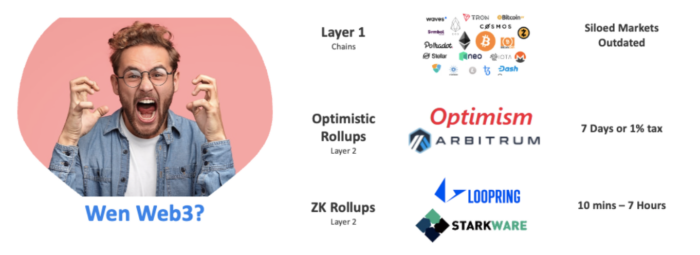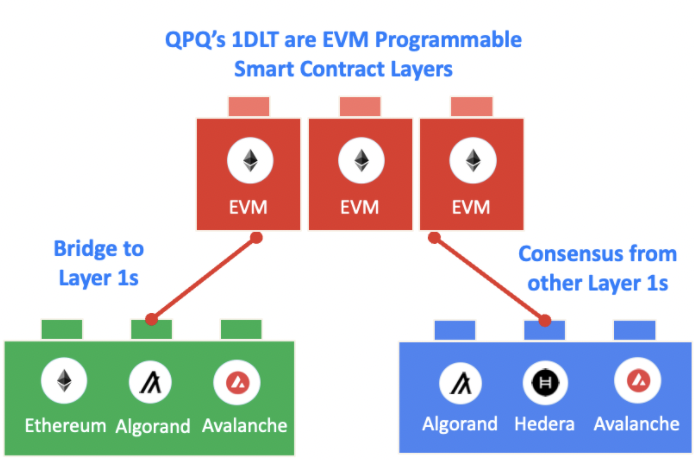
It’s been just over 2 months since the Testnet went live on our website, and what a ride it has been. We received twice the requests for 1DLT than anticipated, requiring us to have to expand our team to cope with the demand. We are grateful for all this engagement and feedback.
Our Alpha, released in April, showed off Consensus As A Service (CAAS). In July, we released our interoperability solution into TestNet. This combination of scaling and interoperability is an absolute must for Web 3.0 right now. This is the layer zero that the Web 3.0 world has long dreamed of, coming to life.
Current alternatives to Layer Zero
Mainstream adoption of Distributed Ledger Technologies (DLTs) and Tokens is already underway. The key challenge for these institutions, other than legal issues, is the user experience of operating on different public chains.
- Ethereum – even post ‘merge’, Ethereum is slow – 20 minutes to settle transactions – and expensive – $20-$25 per transaction in ‘gas’ charges.
- To optimise for speed and cost, DApp builders can choose a DLT protocol other than Ethereum. However, this protocol may have a small market in terms of assets, users, and services. Examples of such layer 1 protocols include Algorand, Hedera, Avalanche, Zilliqa, Fantom, Cardano, Near and so on.
- In the alternative, projects and builders can use an Ethereum Virtual Machine (’EVM’) compatible ‘Layer 2’ that batches transactions, bringing down the cost of operating, but greatly increasing the risk. An example would be a Layer 2 such as Arbitrum, Optimism, Polygon, or the ZK-based networks like StarkNet.
- This blend of layer and layer 2 services operate with highly variable finality: Some reach finality in 2 seconds, whilst others take 10s of seconds, minutes, hours, days, even a week. While it is an engineer’s prerogative to choose the finality of their choice, it is terrible from a user experience perspective. Web 2.0 does not operate in this inconsistent way and it is unlikely to be tolerated in an environment where people are used to seamless convenience.
- To access these siloed networks, users must use a bridge to deposit and withdraw assets. Withdrawal of assets from these networks can take up to 7 days. Even for experienced, technically capable users, this is risky and problematic, so of existing crypto users, 95% of users do not avail of these solutions.
For these reasons, the existing distributed ledger services are failing to provide a real infrastructure layer for Web3. Until users can enjoy the convenience and ease of use that they have become used to in a Web2.0 environment, it is hard to see how Web3.0 can realise its potential.
1DLT’s value proposition: Making it super easy to operate your project and meet user expectations

1DLT does what it says on the tin – it creates a single DLT infrastructure layer that allows users to enjoy Web3.0 as they do Web2.0 – one click away from anywhere. The user experience is defined by the application itself, not the underlying protocols. The infrastructure of 1DLT provides a consistent base of seamless operation across chains with fully decentralised consensus for every operation.
The first commercial iteration of 1DLT provides an Ethereum Virtual Machine (‘EVM’) and provides two key enabling services – Consensus as a Service (‘CaaS’) and Bridge as a Service (‘BaaS’) on a cloud infrastructure that our clients control and operate.
CaaS is an intelligent routing engine that routes EVM operations – mint, burn, trade, swap, etc – to the most efficient public layer 1 protocol for consensus. There is no batching, every transaction is getting public consensus.
1DLT also offers network management and explorer tooling, allowing projects to set up public or private nodes. The Explorer allows users to see the state of the wallet, transactions on each 1DLT network. When fully developed, the explorer allows the user to see and introspect which Layer 1 provided the consensus. Our goal is to provide all the infrastructure to build a highly scalable, secure, and fast DLT network so running Web 3.0 projects become viable.
BaaS is an integrated service within 1DLT that ends the tyranny of third party bridges to connect protocols. This allows projects to have their own dedicated set of micro decentralised bridges. Builders can access networks with just a few clicks without having to worry about hiring an army of developers, performing audits, depending on 3rd party bridges to unlock new markets. From a user perspective, there are no bridges, just a seamless Web3 experience that brings the world of Web3 to within a single click.
QPQ will have the bridges audited by the end of 2022 and add the option of transacting in a trusted execution environment in 2023.
Mainnet in October
QPQ will launch the 1DLT MainNet in the week beginning 3rd of October. We had a lot of feedback on Testnet from users which helped us to finalise our features for mainnet:
- Consensus will be delivered by Algorand and Hedera. This combination gives low-cost, green, fast finality. Our updated whitepaper has a lot of additional designs and data to back our claims of scalability.
- Bridges to Ethereum PoS, Avalanche, Binance, and Arbitrum. If there are other EVM chains that you would like, then please let us know. The bridge code will be available via GitHub using open-source licenses, so it’s easy to access. The developer docs also provide step-by-step guidance on deploying bridges.
- Flex is a new subscription tier that allows you to simply pay for hosting and support. Transactions are paid on an ad-hoc basis. Once you know the number of transactions you need monthly, there are bundled packages that give you hosting, support, and a number of transactions for a single price. Flex is also available on a 14-day free trial on mainnet.
- Testnet will come in two flavours.
- A dedicated instance is free for 14 days before a small monthly fee is charged. It’s useful to choose this as it is a complete replica of the production environment and allows more specific configurations.
- A general-purpose Testnet that is accessible to all for free will also be available later in October which allows you to quickly deploy smart contracts and try the service out.
- We also provide an explorer so you and your users can see the state of the node in terms of wallet address, assets, and transactions. This will later extend to map to Layer 1 which provided the consensus.
You can reach me directly via this mail or leave comments below if there are questions. Happy building!
